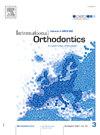第三磨牙发育不全患者的蝶鞍桥接和骨骼矢状模式:一项回顾性观察研究
IF 1.9
Q2 DENTISTRY, ORAL SURGERY & MEDICINE
引用次数: 0
摘要
目的探讨正畸患者第三磨牙发育不全(TMA)的鞍座桥(STB)与骨骼错颌模式的关系。方法选取8 ~ 18岁患者的x线片进行TMA鉴别。所有患者入组时间为2023年3月至2023年6月。对TMA患者(发育不全组,AG)和未TMA患者(对照组,CG)进行侧位头颅x线片检查。使用Mann-Whitney U检验比较两组之间的头侧测量值。根据Leonardi分类,在侧位头颅x线片上对蝶鞍进行分析。在桥接、发育不全、头颅测量、性别和年龄之间进行线性回归。P <; 0.05为显著性。结果共纳入400例患者,其中AG组200例,CG组200例。研究发现,在统计上,发育不全对鞍深测量有显著的影响,特别是在下颌发育不全的情况下,AG的鞍深测量平均高于CG。AG组ANB和A0B0明显低于CG组(P < 0.05),下颌发育不全亚组尤其明显。虽然结果在A0B0和SNB值上有统计学意义,但它们没有临床相关性。AG的颌间角通常减小,表明更倾向于低发散的骨骼模式。与CG相比,AG组关节角、总角、上角和下角值平均略有增加。AG组面部前后高度的百分比比CG组高。最重要的发现是AG的下颌骨体长明显缩短。结论TMA与蝶鞍骨参数无明显相关性。发现TMA与骨骼错咬合,特别是III类错咬合之间可能存在关联。本文章由计算机程序翻译,如有差异,请以英文原文为准。
Sella turcica bridging and skeletal sagittal patterns in patients with third molar agenesis: A retrospective observational study
Objectives
To investigate the associations between sella turcica bridging (STB) and skeletal malocclusion patterns in orthodontic patients with third molar agenesis (TMA).
Methods
Panoramic radiographs were taken from patients aged 8–18 years to identify TMA. All the patients were included between March 2023 and June 2023. Lateral cephalometric radiographs were obtained from both patients with TMA (agenesis group, AG) and those without TMA (control group, CG). Cephalometric measurements between the two groups were compared using the Mann-Whitney U test. The analysis of the sella turcica was carried out on lateral cephalometric radiographs based on Leonardi's classification. Linear regressions were performed between bridging, agenesis, cephalometric measurements, sex and age. Significance was set at P < 0.05.
Results
Four hundred patients were included in the study, 200 for the AG group and 200 for the CG. A statistically significant influence of agenesis on the sella depth measurement, which was on average higher in the AG compared to the CG, was found, particularly in cases of mandibular agenesis. Both ANB and A0B0 were significantly lower in the AG compared to the CG (P < 0.05), especially in the mandibular agenesis subgroup. Although the results are statistically significant for the A0B0 and SNB values, they were not clinically relevant. The intermaxillary angle is generally reduced in AG, indicating a greater tendency towards a hypodivergent skeletal pattern. The values of the joint angles, the total gonial angle, and the upper and lower gonial angles are slightly increased on average in AG compared to CG. The percentage ratio between posterior and anterior facial height is higher in AG compared to CG. The most important finding is that the mandibular body length is significantly shorter in AG.
Conclusions
No significant association was found between TMA and the skeletal parameters of the sella turcica. A possible association was found between TMA and skeletal malocclusions, particularly Class III malocclusions.
求助全文
通过发布文献求助,成功后即可免费获取论文全文。
去求助
来源期刊

International Orthodontics
DENTISTRY, ORAL SURGERY & MEDICINE-
CiteScore
2.50
自引率
13.30%
发文量
71
审稿时长
26 days
期刊介绍:
Une revue de référence dans le domaine de orthodontie et des disciplines frontières Your reference in dentofacial orthopedics International Orthodontics adresse aux orthodontistes, aux dentistes, aux stomatologistes, aux chirurgiens maxillo-faciaux et aux plasticiens de la face, ainsi quà leurs assistant(e)s. International Orthodontics is addressed to orthodontists, dentists, stomatologists, maxillofacial surgeons and facial plastic surgeons, as well as their assistants.
 求助内容:
求助内容: 应助结果提醒方式:
应助结果提醒方式:


